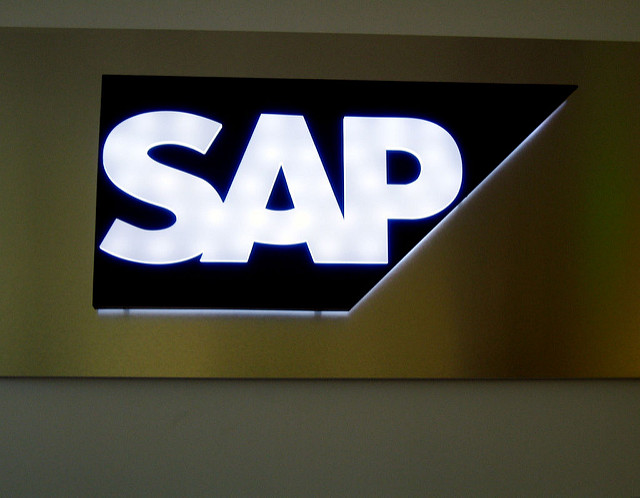SAP Expands HANA Footprint

Photo Credit: Paul Downey/Flickr.com
According to research firm Apps Run the World, the top 10 ERP software vendors accounted for nearly 28% of the global ERP applications market. Overall, the global ERP applications market was estimated to be worth $82.1 billion in license, maintenance, and subscription revenues in 2015. In 2015, SAP (NYSE: SAP) was the leader in the market with 6% market share and $5.3 billion in ERP product revenues, riding on a 23% jump in license, maintenance, and subscription revenues. With its latest product innovations, SAP hopes to maintain that lead.
SAP’s Financials
SAP’s fourth quarter revenues grew 6% over the year to €6.72 billion (~$7.24 billion) compared with the market’s forecast of €6.68 billion (~$7.2 billion). EPS of €1.52 (~$1.64) was also ahead of the Street’s forecast of €1.41 (~$1.52) for the quarter.
Revenues from Cloud and Software grew 6% to €5.76 billion (~ $6.21 billion) with cloud Subscriptions & Support revenues growing 31% to €827 million (~$892 million) and software licenses & support revenues growing 4% over the year to €4.93 billion (~$5.31 billion). The Others segment brought in the remaining revenues of €0.96 billion (~$1 billion).
SAP ended the year with revenues growing 6% to €22.06 billion (~$23.78 billion) and an EPS of €3.03 (~3.27).
For the current year, SAP forecast revenues of €23.2 billion-€23.6 billion (~$25-$25.4 billion), compared with market estimate of €23.5 billion (~25.3 billion).
SAP’s Cloud Growth
SAP remains focused on its Cloud business. It announced plans to invest nearly $4 billion in cash to fuel more growth in the segment. As part of the growth plan, SAP is looking at acquisitions, especially those valued at about $1 billion. It is searching for software companies with capabilities either across industries or in niche areas like networking factories and industrial equipment.
As part of product offerings to drive the growth, SAP is releasing its new software S/4 HANA Cloud Edition, which is a HANA version geared to mid-sized companies with about 1,500 employees. To address the retail customers, it also launched SAP S/4HANA Retail, a version of the platform for merchandise management that will help retailers develop a multi-channel end-to-end retailing solution to cater to the demands of the digital economy. The Retail version’s features include the ability to provide end-to-end support for all core retail processes, meaningful insights into operational retail data and a simple and intuitive user interface.
SAP is already witnessing increasing adoption of HANA by organizations. It ended the recent quarter with 5,400 businesses running the HANA suite, compared with 4,100 a quarter ago. But this is still the tip of the iceberg. 5,400 customers implies that more than 85% of its install base is still in the pipeline and yet to be migrated to HANA.
Given SAP’s plans of growing inorganically, I would point SAP again towards Splunk. At current market capitalization of $8.3 billion, Splunk is definitely beyond the current price range that SAP is scouting for. But, I think that a large acquisition like Splunk would help enhance SAP’s IoT strategy. Splunk, as I have pointed out earlier, is, most likely, also on Microsoft’s radar. So this would be a competitive situation.
SAP’s Enterprise Offerings
Meanwhile, SAP continues to improve its enterprise portfolio to help organizations better manage and govern their data assets. The updates to the Enterprise Information Management portfolio include SAP Data Services that will provide extended support and connectivity for integrating and loading large and diverse data types, including integration with Google BigQuery, Hadoop, SAP HANA Vora, SAP IQ, SAP HANA, and other cloud storage.
The service will also offer optimized data extraction from a HIVE table using Spark and new connectivity support for Amazon Redshift and Apache Cassandra. It will come with SAP Information Steward, which is the latest version to help speed data resolution issues with better usability, policy, and workflow processes. Users are able to view and share data quality scorecards across devices without having to log into the application using the Information Steward.
Other features include SAP Agile Data Preparation that will improve collaboration capabilities between business users and data stewards, SAP HANA smart data integration and smart data quality that will offer new performance and connectivity functionality to deliver faster and real-time replication, bulk/batch data movement, data virtualization and data quality through one common user interface. The portfolio will offer SAP Data Quality Management micro services as a beta on SAP HANA Cloud Platform that will ensure clean data by providing data validation and enrichment for addresses and geocodes within any application or environment.
SAP’s stock is trading at $91.25 with a market capitalization of $110.4 billion. It touched a record high of $92.76 in September last year and had fallen to a 52-week low of $71.39 in June last year.
(Click on image to enlarge)
More investigation and analysis of Unicorn companies can be found in my latest Entrepreneur Journeys book, more



